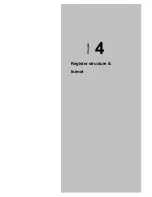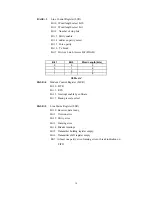
16
4.1 Register Structure
This appendix gives short descriptions of each of the module's registers. For more
information please refer to the data book for the OX16C954 UART chip.
All registers are one byte. Bit 0 is the least significant bit, and bit 7 is the most
significant bit. The address of each register is specified as an offset from the port
base address (BASE).
DLAB is the "Divisor Latch Access Bit”, bit 7 of BASE+3.
BASE+0 Receiver buffer register when DLAB=0 and the operation is a read.
BASE+0 Transmitter holding register when DLAB=0 and the operation is a write.
BASE+0 Divisor latch bits 0 - 7 when DLAB=1.
BASE+1 Divisor latch bits 8 - 15 when DLAB=1
The two bytes BASE+0 and BASE+1 together form a 16-bit number, the divisor,
which determines the baud rate together with the values of TCR and CPR and Bit7
of MCR (Modem Control Register) (refer to 16C954 datasheet). The formula to
set BaudRate as follows:
In formula,
SC
is sample clock value defined by TCR, when TCR=0x00,
SC
=16.
Prescaler
is defined by MCR[7] and CPR.
Prescaler =
1 when MCR[7] = ‘0’;
Prescaler =
M+(N / 8), when MCR[7] =‘1’,
where: M = CPR[7:3] (Integer part – 1 to 31)
N = CPR[2:0] (Fractional part – 0.000 to 0.875 )
While Bit7 of MCR is Logic”1”, TCR=0x00 and CPR=0x40, set the divisor as
follows:
Baudrate
Divisor
Baudrate
Divisor
50
2304
3600
32
75
1536
4800
24
150
768
7200
16
300
384
9600
12
600
192
19200
6
1200
96
38400
3
1800
64
57600
2
2400
48
115200
1
Table 4-1
Summary of Contents for MIC-3620
Page 3: ...1 Chapter 1 Introduction ...
Page 6: ...4 ...
Page 7: ...5 2 Hardware Configuration Chapter ...
Page 12: ...10 ...
Page 13: ...11 3 Pin Assignment Wiring Chapter ...
Page 16: ...14 ...




































